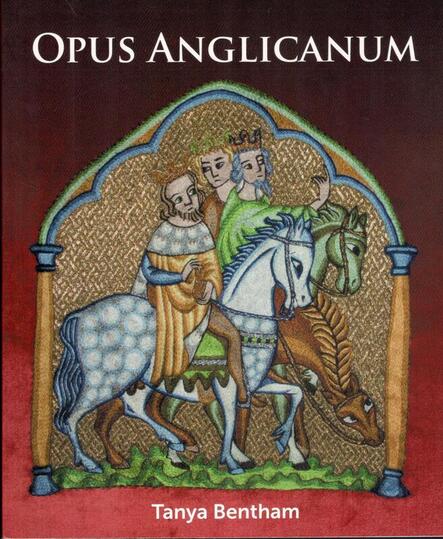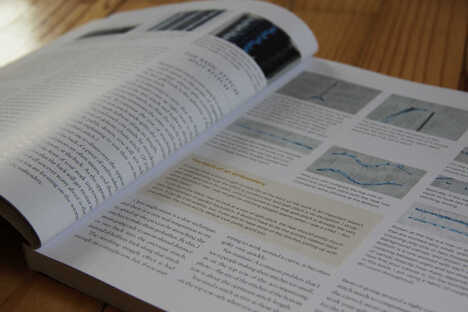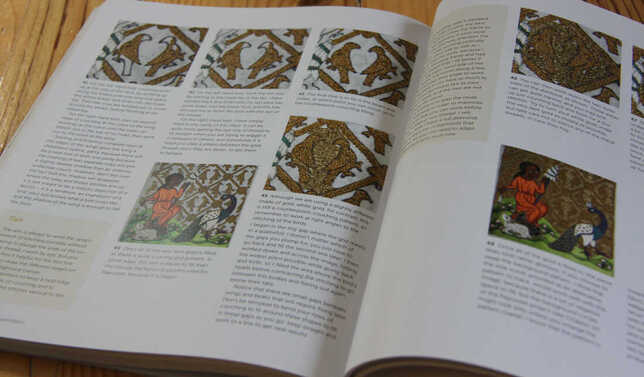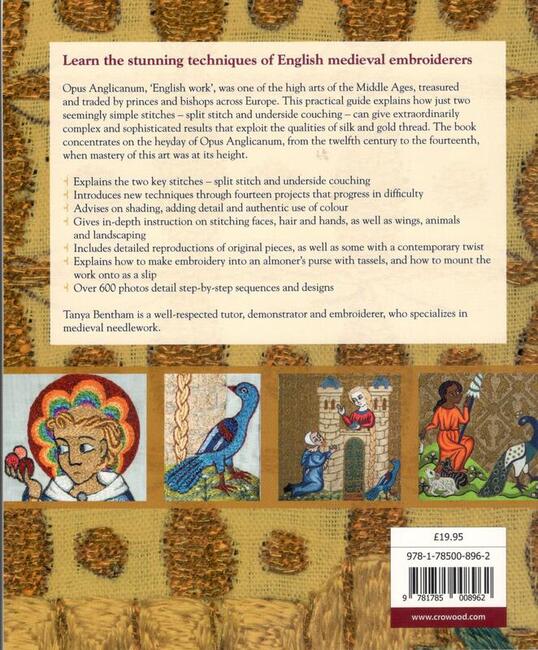|
When I returned from my lovely family visit to the Netherlands, I had one of these pesky little Deutsche Post notes informing me that I had to pick up a parcel in the next village and pay customs duties. As usual, you have no idea which parcel it is until you have paid the outstanding bill and they hand it over to you. To my delight, it was Tanya Bentham's book Opus Anglicanum: a practical guide! I pre-ordered the book as soon as Tanya announced the possibility on her blog. The blog comes highly recommended as the humour with which Tanya both writes and stitches is unsurpassed. I particularly liked her rendition of a medieval watermill with a CCTV camera above the entrance. So let's dive into the book! The book is in essence a paper version of all Tanya's embroidery courses. It is filled to the brim with information and tips from a master embroiderer who has practised her art for many years. Best of all: it is written with the same kind of no-nonsense straight-talking dry humour as her blog is. Things like: "It is slow, too, so, if you need a quick fix, go to do some cross stitch; if you want to get your teeth into something, try opus" in the introduction are not for everyone. However, this is honest advice. You will simply not ever get the same level of mastery as Tanya when you are not equally prepared to sit on your butt and STITCH A LOT. Oh, and don't ever try opus with stranded cotton. Ms Bentham doesn't like it :). The book starts with a chapter on materials, tools and frames. Whilst Tanya stresses that you don't need a lot of fancy stuff to practice opus, it is necessary to use a good (slate) frame that will hold your fabric drum taut (her method of testing with a full bottle of wine is just another version of seeing what happens when a cat sits on it). The next chapter delves into the mighty split stitch. Tanya not only details stitch length but also shows what happens if you still think it is okay to use stranded cotton :). There's also ample information on different types and brands of silk, as well as picking colours. Medieval embroidery is all about the play of light, so what thread you use and how you place your stitches is very important. The split stitch chapter is followed by three project chapters. Each project is shown in clear step-by-step photographs with precise instructions. The projects are tailored in such a way that they increase in difficulty and each teaches you new skills. Opus is not only about the mighty split stitch. Underside couching provides the necessary bling. A whole chapter is devoted to explaining this stitch in depth. And then it is your turn again. Project chapters with (adapted) designs from the Syon cope, the Bologna cope and the Pienza cope give you ample opportunity for wielding your needle. My favourite is "Rumpelstiltskin" with a background of underside couched facing pairs of falcons. Yummy! The last chapters in the book deal with applying your finished embroideries as slips onto something else and assembling an almoner's purse. The last pages are filled with designs drawings and a list of suppliers. As said before, the book is packed with tips and troubleshooting. This shows that Tanya is really at the top of her game. A master is not somebody who does not make mistakes, but who knows how to fix them when they inevitably happen. Everything Tanya knows about opus is in here. No information is kept from you. If you want to sink your teeth into opus, follow Tanya's instructions and practice a lot. Along the way, you will pick up the confidence and skill to work your own masterpieces!
Anything I didn't like about the book? Yes. The binding and the cover aren't very sturdy. This makes a book cheaper to produce (GBP 19,95 is a steal for a 208-page book with over 600 pictures!), but it is a trade-off when it comes to longevity. Furthermore, I would have liked to see a suppliers list with entries for mainland Europe, North America and Australia/New Zealand. After all, this book was not written for UK stitchers only. With protectionism on the rise, knowing where to source materials in your own region becomes increasingly important as shipping costs and customs duties are getting insane. Where to find the book? Please order from Tanya directly! Writing a book does not make you rich. On the contrary. When you order from the writer directly, she/he will get the maximum financial return. Literature Bentham, T., 2021. Opus Anglicanum: a practical guide. Marlborough, Crowood. ISBN 978 1 78500 896 2.
4 Comments
|
Want to keep up with my embroidery adventures? Sign up for my weekly Newsletter to get notified of new blogs, courses and workshops!
Liked my blog? Please consider making a donation or becoming a Patron so that I can keep up the good work and my blog ad-free!
Categories
All
Archives
July 2024
|
Contact: info(at)jessicagrimm.com
Copyright Dr Jessica M. Grimm - Mandlweg 3, 82488 Ettal, Deutschland - +49(0)8822 2782219 (Monday, Tuesday, Friday & Saturday 9.00-17.00 CET)
Impressum - Legal Notice - Datenschutzerklärung - Privacy Policy - Webshop ABG - Widerrufsrecht - Disclaimer
Copyright Dr Jessica M. Grimm - Mandlweg 3, 82488 Ettal, Deutschland - +49(0)8822 2782219 (Monday, Tuesday, Friday & Saturday 9.00-17.00 CET)
Impressum - Legal Notice - Datenschutzerklärung - Privacy Policy - Webshop ABG - Widerrufsrecht - Disclaimer










 RSS Feed
RSS Feed